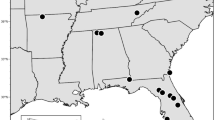Abstract
In field tests of the information-center hypothesis (ICH) in south Texas with black vultures (Coragyps atratus) and turkey vultures (Cathartes aura), large carcasses were provided and kept under continuous observation. The use vultures made of these bait sites and their patterns of arrival were recorded to evaluate predictions derived from the ICH. Turkey vultures discovered most bait sites (30 of 31) first, but frequently were displaced from the food by later-arriving black vultures. This competitive exclusion by black vultures limited subsequent feeding opportunities for turkey vultures sufficiently that few (27%) returned on subsequent days to bait sites they had previously visited. I found no evidence that those turkey vultures that did return to bait sites acted as leaders for groups of naive birds and led them to bait sites – knowledgeable and naive turkey vultures did not arrive at bait sites together, and groups arriving at bait sites were not larger on subsequent days than on the first days carcasses were available. In contrast, a significantly larger percentage (47%) of knowledgeable black vultures returned to bait sites they had visited on previous days, and the first groups of black vultures arriving at bait sites on subsequent days were significantly larger than the equivalent groups on first days. Nine flocks of black vultures that arrived on subsequent days at bait sites before sunrise (which suggests the birds had commuted directly from a roost) contained knowledgeable birds, and two of these flocks contained both knowledgeable and naive individuals. Overall, 10 of 54 naive tagged black vultures (18.5%) arrived at bait sites under circumstances that suggested they had followed conspecifics to the food from a roost. However, most black vultures apparently found carcasses through independent search or by using local enhancement. Therefore, I conclude that while following from roosts to food sites is a strategy used by black vultures, at this study site it is one they use relatively infrequently.
Similar content being viewed by others
Author information
Authors and Affiliations
Additional information
Received: 20 February 1997 / Accepted after revision: 28 June 1997
Rights and permissions
About this article
Cite this article
Buckley, N. Experimental tests of the information-center hypothesis with black vultures (Coragypsatratus) and turkey vultures (Cathartesaura). Behav Ecol Sociobiol 41, 267–279 (1997). https://doi.org/10.1007/s002650050388
Issue Date:
DOI: https://doi.org/10.1007/s002650050388




